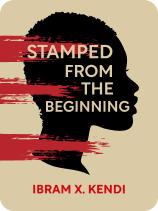

This article is an excerpt from the Shortform book guide to "Stamped from the Beginning" by Ibram X. Kendi. Shortform has the world's best summaries and analyses of books you should be reading.
Like this article? Sign up for a free trial here.
Who invented race classification? How did slave owners justify Black inferiority?
The post-colonial period saw the invention of racial hierarchies, which were justified by the pseudoscientific theories of that time. The purpose of the hierarchy of race was two-fold: justifying Black inferiority and preventing slave uprisings.
Keep reading to learn about the origins of race classification.
Pseudoscientific Racial Hierarchies
During the Colonial era, pro-slavery forces found support in new scientific attitudes about race. From around 1730 to 1760, Enlightenment scientists like taxonomist Carl Linnaeus established pseudoscientific racial hierarchies that placed Europeans at the top (attributing to them qualities like intelligence, ingenuity, and lawfulness) and Africans at the bottom (citing traits like laziness, neglectfulness, and capriciousness). These hierarchies inspired similar hierarchies within the slave trade, as enslavers ranked slaves according to their national and ethnic origins, which were thought to determine a slave’s utility for various kinds of work.
Kendi points out that race classification served two social purposes. First, they justified slavery by perpetuating the idea that Black people were inferior and benefited from slavery’s civilizing influence. Second, they helped prevent slave uprisings by widening the rift between poor white people and poor and enslaved Black people while also introducing racist divides within enslaved populations by ranking some slaves as “better” than others.
(Shortform note: A hierarchy of race may serve an additional purpose—imposing order on society. In Sapiens, Yuval Noah Harari argues that social hierarchies exist because they offer guidelines for interacting with people you don’t know personally. In other words, Harari argues that hierarchies—especially when they’re based on visual cues like skin color—help us determine who to interact with and how. Similarly, in Caste, Isabel Wilkerson argues that American racism is best understood as a caste system, meaning that it serves as the basis of social order by dividing people into groups and prescribing appropriate behaviors and lifestyles for each group.)
| Defining “Racism” and “Race” Racism is a charged term, so before going further, it’s a good idea to establish its definition and usage in this guide. In Stamped from the Beginning, Kendi defines racism as “any concept that regards one racial group as inferior or superior to another racial group in any way.” In other words, racism doesn’t require hatred or discrimination—it only requires believing that any race is better or worse than another. As we’ll see, this definition will be important for understanding Kendi’s arguments about the different kinds of thoughts about race. However, this definition raises another question: What is race? Kendi never explicitly defines the term in Stamped from the Beginning, but in How to Be an Antiracist, he defines it as a hierarchical group into which people are sorted. He argues that race isn’t based on culture, ethnicity, or biological difference—instead, he says, it’s a purely political construct. As we’ll see, that construct changes over time depending on which era and which culture we’re looking at. But in any case, it’s important to note that despite centuries of pseudoscientific claims of racial difference, contemporary science has found no significant biological difference between so-called racial groups. |

———End of Preview———
Like what you just read? Read the rest of the world's best book summary and analysis of Ibram X. Kendi's "Stamped from the Beginning" at Shortform.
Here's what you'll find in our full Stamped from the Beginning summary:
- How enslavers convinced themselves that slavery benefited slaves
- Why most antiracist reformers harbored racist thoughts
- How to achieve an antiracist society






